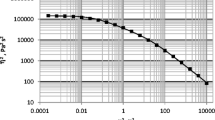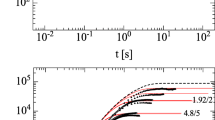Summary
Five normal stress, two viscosity, and two flow birefringence measurements have been made with a 2% solution of polyisobutene (M w =4.5× 106) in a polyisobutene liquid (M w = 400, viscosity = 0.25 Poise) at 25 °C at shear rates in the range 1 to 30 sec−1 using apparatus listed in table 1. Values forp 11 −p 22 obtained from (a) extinction angle and shear stress, and from (b) total thrust in a cone- and-plate apparatus are in excellent agreement. From these values ofp 11−p 22 and values ofp 11+p 22−2p 33 (obtained from pressure gradients in a cone- and-plate apparatus), values ofp 33−p 22 are derived which are positive and small [<0.07 (p 11−p 22)].
Between these values ofp 33−p 22 and values of rim pressure, there is a discrepancy which is attributed to pressure contributions from (i) flow in the ‘sea’ of liquid outside the rotating cone, and (ii) perturbations in shear flow caused by the small holes used in pressure measurements. For small gap angles, (i) is negligible and the value ofpH [contribution (ii)] is deduced from the data.pH is large (about −2 ¦p 21¦) and negative. These values ofpH, p 11−p 22, andp 22−p 33 are used to predict successfully the values of pressure gradient in a plate- and-plate system [2.13]. The values ofp 33−p 22 are however, about three times smaller than values derived from measurements ofdF/dc, whereF=total thrust in a cone- and-plate apparatus whenc=distance between plate and cone apex.
Zusammenfassung
Mit der Apparatur nach Abb. 1 wurden jeweils die Normalkraft fünfmal, die Viskosität zweimal und die Strömungsdoppelbrechung gemessen. Verwendet wurde eine 2% Lösung von Polyisobutan (M w ≈ 4,5× 106) in flüssigem Polyisobutan (M w ≈ 400,n s =0,25P) bei 25 °C und Deformationsgeschwindigkeiten im Bereich vonG=1---30 s−1. Die Wertep 11−p 22, die a) aus dem Auslöschungswinkel und der Scherkraft und b) aus der Normalkraft in einem Kegel-Platte-Gerät gewonnen wurden, stimmen hervorragend überein. Aus diesen Wertenp 11−p 22 und aus Wertenp 11−p 22-2p 33 (gewonnen aus den Druckgradienten im Kegel-Platte-Gerät) werden Wertep 33−p 22 abgeleitet. Diese sind klein (<0,07 (p 11−p 22) und positiv.
Es besteht ein Unterschied zwischen den Wertenp 33-p 22 und dem Randdruck. Die Ursache dafür sind Druck-einflüsse von (i) Strömung in der Flüssigkeit außerhalb des sich drehenden Kegels und (ii) Störungen in der Scherströmung als Folge der kleinen Bohrungen für die Druckmessungen. Für kleine Spaltwinkel ist (i) vernachlässigbar und der WertpH (Druckeinfluß (ii)) wird aus den Versuchswerten gewonnen. Die WertepH sind groß (etwa −2 ¦p 21¦) und negativ.
Mithilfe der WertepH, p 11−p 22 undp 22−p 33 können die Druckgradienten in einem Platte-Platte-System gut vorausgesagt werden [2.13]. Jedoch sind die Wertep 33−p 22 etwa dreimal kleiner als solche, die aus der Messung vondF/dc gewonnen wurden, wobeiF die Normalkraft im Kegel-Platte-Gerät ist undc der Abstand zwischen Konusspitze und Platte.
Similar content being viewed by others
Abbreviations
- Oy 1 y 2 y 3 :
-
Local rectangular Cartesian coordinate system;Oy 1 tangential to line of shear;Oy 2 normal to shearing surface
- G :
-
Shear rate (a non-zero principal value of the rate-of-strain tensor). [In rectilinear shear flow, velocity componenteυ i are given byυ 1=G y 2,υ 2=υ 3=0, withG>0.]
- r :
-
Distance of a typical point in the plate from axis of rotation
- R :
-
Radius of rotating cone or plate
- r 0,r i :
-
Radii of outer and inner cylinders
- θ0 :
-
Gap angle (cone semi-vertical angle = 1/2π−θ 0)
- h :
-
Separation between cone and plate at distancer from axis
- c:
-
Value ofh atr=0. (distance between plate and point of intersection of cone generators)
- z 0 :
-
Separation between plate and plate
- p :
-
Cartesian stress tensor
- pij :
-
Components ofp referred toOy 1 y 2 y 3 (=physical components) (p ii >0 for a tensile normal stress component) (i, j=1, 2, 3)
- pI,pII:
-
Principal values ofp associated with principal axes inOy 1 y 2
- x′ :
-
Inclination of principal stress axis I (lying in positive quadrant of0y 1 y 2) toOy 1
- Δp :
-
pI−pII
- p a :
-
Atmospheric pressure
- p (r) :
-
Pressure on plate at point distantr from axis of rotation, as measured by means of liquid-filled hole in the plate
- pH :
-
(pressure attributed to flow perturbation caused byhole used to measure pressure) (pH ≡ p+p 22)
- η :
-
p 21/G (= viscosity of solution)
- η s :
-
viscosity of solvent
- F :
-
Total thrust on cone rotating at angular velocityΩ 0 minus corresponding thrust at zero angular velocity
- Ω 0 :
-
Angular velocity of rotating member
- n:
-
Refractive index tensor (defined as (ϰ/ϰ0)1/2), where ϰ and ϰ0 1 denote permittivity tensors for the flowing solution and for free space respectively)
- nI,nII:
-
Principal values ofn corresponding to principal axes I, II lying in plane0 y 1 y 2
- Δn :
-
nI−nII
- χ :
-
Inclination of principal axis I toOy 1 (axis I lies in positive quadrant of planeOy 1 y 2). (χ=‘extinction angle’)
- 1 :
-
Unit tensor
- ϱ :
-
Density of liquid
References
Lipson, J. M. andA. S. Lodge, Rheol. Acta (paper I) R. A. 363.
Kaye, A. andD. W. Saunders, J. Sci. Instrum.41, 139 (1964).
Adams, N. andR. Jackson, J. Sci. Instrum.44, 461 (1967).
Jackson, R. andA. Kaye, Brit. J. Appl. Phys.17, 1355 (1966).
Adams, N. andA. S. Lodge, Phil. Trans. Roy. Soc. A265, 149 (1964).
Broadbent, J. M., A. Kaye, A. S. Lodge, andD. G. Vale, Nature (London)217, 55 (1968).
Lodge, A. S., Elastic Liquids (London-New York 1964), Ch. 9.
Oldroyd, J. G., Proc. Roy. Soc. A200, 523 (1950).
Coleman, B. D., H. Markovitz, andW. Noll, Viscometric Flows of Non-Newtonian Fluids (Berlin-Heidelberg-New York 1966).
Kaye, A., Flow Problems with Rheologioal Equations of State, (D. Phil. Thesis, University of Oxford 1965) p. 105.
Lodge, A. S., Nature (London)176, 838 (1955).
Philippoff, W., J. Appl. Phys.27, 984 (1956).
Philippoff, W., F. H. Gaskins, andJ. G. Brodnyan, J. Appl. Phys.28, 1118 (1957).
Janeschitz-Kriegl, H., Makromol. Chem.33, 55 (1959).
Zimm, B. H., J. Chem. Phys.24, 269 (1956).
Lodge, A. S., Kolloid-Z.171, 46 (1960).
den Otter, J. L., Dynamic Properties of Some Polymeric Systems, (Doctoral Thesis, University of Leyden 1967).
Thom, A. andC. J. Apelt, Rep. Memor. Aero. Res. Coun. no. 3090 (London, H. M.S.O. 1958).
Greensmith, H. W. andR. S. Rivlin, Phil. Trans. Roy. Soc. A245, 399 (1953).
Markovitz, H., Phys. Fluids8, 200 (1965).
Author information
Authors and Affiliations
Rights and permissions
About this article
Cite this article
Kaye, A., Lodge, A.S. & Vale, D.G. Determination of normal stress differences in steady shear flow. Rheol Acta 7, 368–379 (1968). https://doi.org/10.1007/BF01984855
Received:
Issue Date:
DOI: https://doi.org/10.1007/BF01984855




